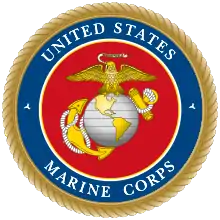Marine Aviation Training Support Group 22
Marine Aviation Training Support Group 22 (MATSG-22) is a United States Marine Corps aviation training group that was originally established during World War II as Marine Aircraft Group 22 (MAG-22). Squadrons from MAG-22, were decimated at the Battle of Midway and after reconstituting fought during the Battle of Okinawa. The group was deactivated following the end of the war and were not reactivated until May 1, 2000 when the Marine Aviation Detachment at Naval Air Station Corpus Christi, Texas was renamed MATSG-22.
| Marine Aviation and Training Support Group 22 | |
|---|---|
 MATSG-22 insignia | |
| Active | March 1, 1942 - Unknown January 15, 1982 - present |
| Country | United States |
| Branch | United States Marine Corps |
| Role | Training |
| Garrison/HQ | Naval Air Station Corpus Christi |
| Nickname(s) | Foreign Legion of Marine Aviation |
| Engagements | World War II * Battle of Midway * Battle of Okinawa |
| Commanders | |
| Current commander | Col Brett H. Ritterby, USMC |
| Notable commanders | William J. Wallace Ira L. Kimes |
History
MAG-22 history
Marine Aircraft Group 22 was formed at Midway Atoll on March 1, 1942 under the command of Colonel William J. Wallace. From its inception until several months after the war it did not serve within the continental limits of the United States, hence earned the popular name of "Foreign Legion of Marine Aviation". During World War II, MAG-22 participated in combat at:
- 3–6 June 1942 – Battle of Midway (under the command of Ira L. Kimes)
- 20 February- 2 March 1944 - Marshal Island Operation
- 26 March 1944 – Ponape
- 2 May-14 July 1945 - Battle of Okinawa
The first enemy plane shot down by a MAGG-22 aircraft occurred on 10 March 1942 when a 4-plane section from VMF-221 engaged a Japanese Kawanishi H6K 45 miles from Midway Atoll. Upon their return, the MAG Commanding Officer, LtCol William J. Wallace, presented the pilots a bottle of bourbon for their efforts.
Marine Aerial Navigation School history
Aerial navigation training first began for the Marine Corps in 1942 when five Marine officers were assigned to the Weems School Of Navigation in Annapolis, Maryland. After completing this course, these five officers became the nucleus who established the navigation school at Camp Kearny in San Diego, California. A year later the school was moved to Marine Corps Air Station Cherry Point, North Carolina where they graduated their first class of navigators in January 1945. This training program existed only as a ground school. In March 1948 the school was disbanded.
In March 1952 after the beginning of the Korean War, the Aerial Navigation School was reactivated as part of the Airborne Operation School located at MCAS Cherry Point. The Airborne Operation School consisted of the Aerial Navigation School, Radio Operator School and the Electronic Countermeasures School. During this time Marine Navigators trained in such aircraft as C-54s, R4D-6s, and R4D-8s (Super DC-3). The Aerial Navigation School remained at Cherry Point until January 1971 at which time it was moved to Naval Air Station Pensacola, Florida, where the Navy assumed responsibility for flight support. A detachment of T-29 aircraft from VT-29 NAS Corpus Christi, which had been previously assigned for Navy support, now provided flight support for the Aerial Navigation School. At this point the name of the school was changed to the Marine Aerial Navigation School (MANS).
After two years at Naval Air Station Pensacola, the Navy moved the detachment of T-29s and the Marine School moved to NAS Corpus Christi in order to continue the T-29 support. Due to the phasing out of the T-29s in 1976 at Corpus Christi, the Marines of MANS were then relocated to Mather Air Force Base, CA, where they utilized the T43 aircraft. In January 1993, MANS was once again relocated to Randolph AFB, TX. Marine instructors utilizing the 12th Flying Training Wing navigation training facilities staff the Marine Aerial Navigation School (MANS). The command mission of the Marine Aerial Navigation School is to train and qualify enlisted Marines in the "Scientific Art of Navigation" and as Navigators of tactical transport aircraft in support of the Fleet Marine Force.
2000 - present
In May 2000, the Commandant of the Marine Corps directed the re-designation of Marine Aviation Detachment NAS Corpus Christi as Marine Aviation Training Support Group 22. All Marine Aviation Training Support Groups were redesignated to promote a sense of Marine Corps identity and tradition and allows them and their history to live on.
Awards
- Presidential Unit Citation with two silver bands
- Asiatic-Pacific Campaign Medal with three bronzes stars
- Navy Occupation Service Medal with Asia clasp
